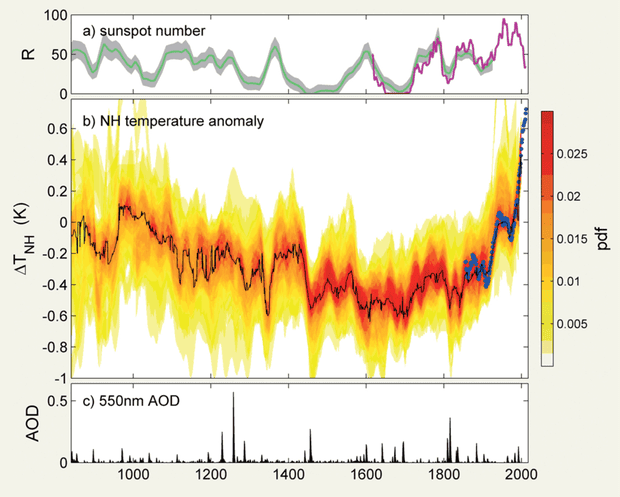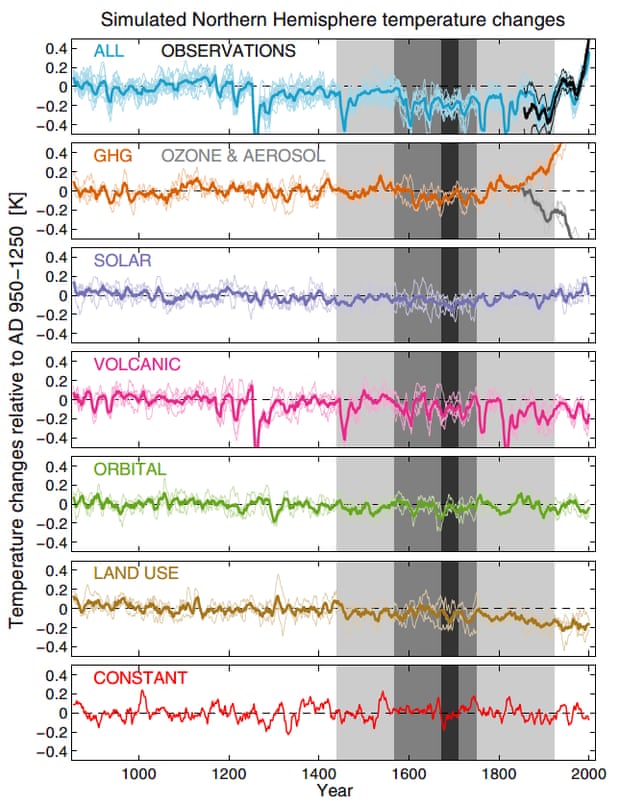The 'imminent mini ice age' myth is back, and it's still wrong
Posted on 9 January 2018 by dana1981
This post has been incorporated into the rebuttal to the myth A grand solar minimum could trigger another ice age
Roughly every two years we’re treated to headlines repeating the myth that Earth is headed for an imminent “mini ice age.” It happened in 2013, 2015, and again just recently at the tail end of 2017.
This time around, the myth appears to have been sparked by a Sky News interview with Northumbria University mathematics professor Valentina Zharkova. The story was quickly echoed by the Daily Mail, International Business Times, Sputnik News, Metro, Tru News, and others. Zharkova was also behind the ‘mini ice age’ stories in 2015, based on her research predicting that the sun will soon enter a quiet phase.
The most important takeaway point is that the scientific research is clear – were one to occur, a grand solar minimum would temporarily reduce global temperatures by less than 0.3°C, while humans are already causing 0.2°C warming per decade.

The global mean temperature difference is shown for the time period 1900 to 2100 for the IPCC A2 emissions scenario. The red line shows predicted temperature change for the current level of solar activity, the blue line shows predicted temperature change for solar activity at the much lower level of the Maunder Minimum, and the black line shows observed temperatures through 2010. Illustration: Adapted from Feulner & Rahmstorf (2010) in Geophysical Research Letters by SkepticalScience.com
So the sun could only offset at most 15 years’ worth of human-caused global warming, and once its quiet phase ended, the sun would then help accelerate global warming once again.
The ‘mini ice age’ misnomer
The myth ultimately stems from a period climate scientists have coined “The Little Ice Age” (LIA). This was a modestly cool period running from about the year 1300 to 1850. It was particularly cold in the UK, where the Thames River sometimes froze over, and ‘frost fairs’ were held.
A team led by University of Reading physicist and solar expert Mike Lockwoodwrote a paper reviewing the science behind frost fairs, sunspots, and the LIA. It included the figure below showing northern hemisphere temperatures along with sunspot number and the level of volcanic particles in the atmosphere over the past millennium:

Sunspot number, northern hemisphere temperatures, and volcanic aerosol optical depth (AOD) around the time of the Little Ice Age. Illustration: Lockwood et al. (2017), News & Reviews in Astronomy & Geophysics
During full blown ice ages, temperatures have generally been 4–8°C colder than in modern times. As this figure shows, during the LIA, temperatures were at most only about 0.5°C cooler than the early 20th century. Thus, Lockwood calls the Little Ice Age “a total misnomer.” As the authors put it:
Compared to the changes in the proper ice ages, the so-called Little Ice Age (LIA) is a very short-lived and puny climate and social perturbation.
For comparison, temperatures have risen by a full 1°C over the past 120 years, and 0.7°C over just the past 40 years.
The minimal solar minima influence on the climate
The Maunder Minimum was a period of quiet solar activity between about 1645 and 1715. It’s often referred to interchangeably with ‘Little Ice Age,’ but the latter lasted centuries longer. In fact, three separate solar minima occurred during the LIA, which also included periods of relatively higher solar activity. Other factors like volcanic eruptions and human activities also contributed to the cool temperatures. In fact, a 2017 paper led by the University of Reading’s Mathew Owens concluded:
Climate model simulations suggest multiple factors, particularly volcanic activity, were crucial for causing the cooler temperatures in the northern hemisphere during the LIA. A reduction in total solar irradiance likely contributed to the LIA at a level comparable to changing land use [by humans].
Simulated northern hemisphere temperature changes resulting from individual climate factors, as compared to the observed changes in the top panel. The bottom panel shows a simulation with no changes to climatological factors, to illustrate the level of natural variability in the climate. Illustration: Owens et al. (2017), Journal of Space Weather and Space Climate
Several studies have investigated the potential climate impact of a future grand solar minimum. In every case, they have concluded that such a quiet solar period would cause less than 0.3°C cooling, which as previously noted, would temporarily offset no more than a decade and a half’s worth of human-caused global warming. These model-based estimates are consistent with the amount of cooling that occurred during the solar minima in the LIA.
Is another grand solar minimum imminent?
Although it would have a relatively small impact on the climate, it’s still an interesting question to ask whether we’re headed for another quiet solar period. Zharkova thinks so. Her team created a model that tries to predict solar activity, and suggests another solar minimum will occur from 2020 to 2055. However, other solar scientists have criticized the model as being too simple, created based on just 35 years of data, and failing to accurately reproduce past solar activity.
Ilya Usoskin, head of the Oulu Cosmic Ray Station and Vice-Director of the ReSoLVE Center of Excellence in Research, published a critique of Zharkova’s solar model making those points. Most importantly, the model fails in reproducing past known solar activity because Zharkova’s team treats the sun as a simple, predictable system like a pendulum. In reality, the sun has more random and unpredictable (in scientific terms, “stochastic”) behavior:































 Arguments
Arguments































the sun is at minimum now,so the only thing happening is the sun is skipping a solar maximum or two.the result is the temparature might increase slower or stop for a few years.
this means the sun will keep at the energy output it has now but not increase as it does during a normal maximum.
So in other words we know that a certain level of change in solar irradiance causes a certain change in temperature, and its quite small compared to CO2. So a solar minimum would be weak.
But the predicted so called coming "grand solar minimum" is just a guess. We don't really know the exact causes and periodicity of these cycles, and they appear random, so we are guessing that because solar activity increased from about 1600 to the 1970s, it 'might' be time for a decline of some sort, - like an economic downturn. This is just pure presumption. It could equally stay flat for decades to come, or even increase reinforcing agw.
Recommended supplemental reading...
No, we’re not slipping into a proper ice age, ...and Then There's Physics, Jan 8, 2018
This sounds more like economic predictions than hard science to me.
Guessing how the interactions of a massive ball of plasma under the influence of gravity, intense magnetic fields and incredible heat at the core where fusion is taking place constantly is not like a pendulum over long periods of time. The Sun is a dynamic evolving system which means that it is not the same as it was even hundreds of years ago and it is much different now than it was millions of years ago. At some point it will not even be recognizable as our Sun.
And its output is progressively increasing, though over the scale of hundreds and thousands of years this is not that significant.
It is just as valid to assume that we could see a period of increased solar activity and a positive radiative forcing of the Earth than a deep minimum.
Ice ages do not come about as a result of radiative forcings of the Sun, they are the result of long term changes in the orbital dynamics of the Earth, the eccentricity of the eliptical orbit, the axial tilt and precession of the earth as it wobbles on its axis.
These forcings are tiny compared to what human created forcings have done in the last 150 years and require thousands of years to take a mostly ice free Northern Hemisphere and turn it into one covered by thick ice sheets that reached as far as south of the Great Lakes in North America.
This has been completely swamped by the effects alone of hundreds of billions of tons of carbon dioxide being introduced into the carbon cycle by human activity. There will be no ice age as long as we burn fossil fuels and if we keep burning as much as we are now even a record solar minimum like the one we just had will only slow the process of global warming as the article states.
With the coincidence of a deep solar minimum and a strong La Nina a few years ago the Earth should have seen a record low average yearly temperatures. We did not, they were still in the upper levels of temperature records.
This seems to me to be just one more attempt to deny valid evidence of global warming.
[JH] Am I correct in assuming that the "this" you refer to in the initial and final paragraphs of your comment is Matt Ridley's article that the OP debunks?
@JH
The "this" I was referring to is the belief that we can predict the long term changes in Solar output and then base policy on that.
Which seems to be the focus on a lot of these attempts to create doubt of whether we are in a warming phase - almost all the evidence says so - or at the edge of a cooling phase.
Based on the relative radiative forcings even a short term cooling phase is highly unlikely, the positive radiative forcing of the additional carbon dioxide alone we've added to the Earth's atmosphere is many times the negative forcings that result in full blown ice ages. The relative minor negative forcing of a prolonged Solar minimum would result in a slowing of global warming, not a cooling of the Earth. As the article above states.
[JH] Thanks for the clarification.
thanks for this article.
i have previously researched this too and read (somewhere?) that the maunder minimum in the 1600's was estimated to have been caused by a -.4C (cooling).
this caused me to question the current line of thinking which says +2C is a "safe" limit for warming, because if -.4 caused a little ice age, how the heck can +2C be "ok"??
also it is very disconcerting that we are still warming when we should be cooling! yikes!
A paper (forgot the reference, sorry) last year suggested that changes in ocean currents in the north sea also contributed to make winters more severe during the little ice age.
About the news: if you follow the link, you'll get to an article from Sky News and there is only two quotes from the professor in it. So it is not an interview. And you could note that the journalist was promoting the idea of a little ice age, whilst the professor point of view was extremely cautious about it.
Be aware of the media, my friends!